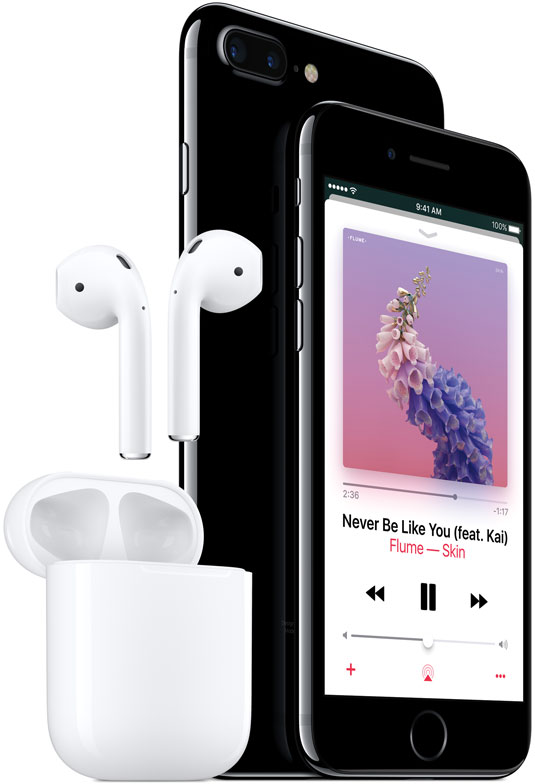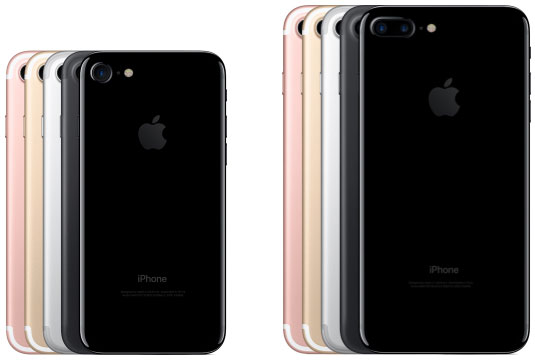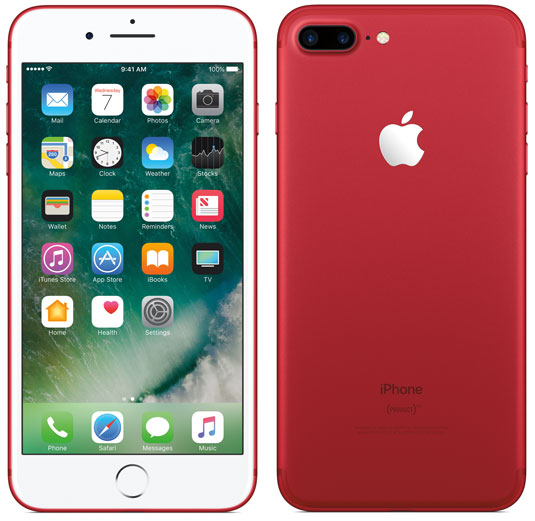Hosted by site sponsor WebMate.
iPhone Q&A
Update Published October 13, 2022
All Apple Q&As >> iPhone Q&A (Home)
To be notified of new Q&As, sign up for EveryMac.com's bimonthly email list.
What are all the differences between the iPhone 7 and iPhone 7 Plus models? How many are there around the world?
Please note that the iPhone 7 and iPhone 7 Plus models have been discontinued. However, this Q&A has been updated subsequently with the latest iOS compatibility details and more and can be quite helpful to anyone buying or selling one of these devices on the used market.
It would be tempting to take a quick glance at the iPhone 7 and iPhone 7 Plus next to one another and determine that the iPhone 7 Plus simply is a bigger version of the iPhone 7.
Although the size is an important difference between these devices, there are other differences that are less obvious and that still are important. In fact, the difference between these models is more substantial than earlier iPhone models released at the same time.

Photo Credit: Apple, Inc. (iPhone 7 - Front, iPhone 7 Plus - Rear, Airpods)
It also is worth noting that there actually are four iPhone 7 and four iPhone 7 Plus models sold around the world. Specifically, there is the iPhone 7 (Verizon/Sprint/China), iPhone 7 (AT&T/T-Mobile/Global), iPhone 7 (Japan), and iPhone 7 (China Mobile) as well as the iPhone 7 Plus (Verizon/Sprint/China), iPhone 7 Plus (AT&T/T-Mobile/Global), iPhone 7 Plus (Japan), and iPhone 7 Plus (China Mobile). On March 21, 2017, Apple added a (PRODUCT) RED Special Edition version of each model.
There are carrier support and other differences between these models that are important to understand. The similarities of each model are useful to know, also.
External Differences & Similarities
Both the iPhone 7 and iPhone 7 Plus models use all aluminum cases with softly rounded sides and are splash, water, and dust-resistant (IP67), but they are not water-proof.
Both lines have stereo speakers and a Lightning port, as well as a taptic-engine powered solid state "clickless" Home button with integrated "Touch ID" fingerprint capabilities, but they do not have a traditional headphone jack.
Both lines also have a multitouch "Retina HD" display with support for a "wide color" gamut (DCI-P3), dual domain pixels for wider viewing angles, 625 cd/m2 maximum brightness, and 3D touch capabilities, as well.
However, the 4.7" (1334x750) display in the iPhone 7 has a modestly better typical contrast ratio (1400:1) compared to the 5.5" (1920x1080) display in the iPhone 7 Plus, which has a 1300:1 typical contrast ratio. On the other hand, the iPhone 7 Plus has a higher pixel density, 401 ppi compared to 326 ppi for the iPhone 7. You would have to have particularly sharp vision to differentiate the higher pixel density of the iPhone 7 Plus, but it is worth noting nevertheless.

Photo Credit: Apple, Inc. (iPhone 7 & iPhone 7 Plus Original Color Options)
Both models originally were available in five color options, more than any previous iPhone model. These color options are (1) a pink hued "Rose Gold," (2) Gold, and (3) Silver, all of which have a white glass front, as well as (4) Black, which has a black glass front and a matte finish black aluminum back, and (5) "Jet Black," which has a black glass front and a high gloss black anodized and polished black aluminum back.
Apple disclaims that the "Jet Black" finish may show scratches with use and perhaps is best either avoided by those who are particularly concerned by scuffs or alternately held securely within a protective case.
On March 21, 2017, Apple added a (PRODUCT) RED Special Edition model which has a white glass front and a matte finish red aluminum back.

Photo Credit: Apple, Inc. (PRODUCT RED iPhone 7 Plus)
Other than its color difference, the (PRODUCT) RED Special Edition iPhone 7 is identical to its corresponding "regular" model, but Apple contributed a small amount of money to HIV/AIDS research for each sale. Apple discontinued this model on September 12, 2017.
Camera Differences
The iPhone 7 and iPhone 7 Plus each have an identical "FaceTime HD" camera on their respective fronts. This camera has a 7 megapixel sensor, an f/2.2 aperture, and records 1080p HD video.
The rear cameras, though, are substantially different from one another.
The iPhone 7 has a rear camera with a 12 megapixel sensor, an f/1.8 aperture, and digital zoom up to 5x for still photos and up to 3x for video recording. The iPhone 7 Plus, on the other hand has two rear cameras -- a 12 megapixel wide-angle camera with a an f/1.8 aperture and a 12 megapixel telephoto camera with a f/2.8 aperture. Collectively, these two cameras provide an effective optical zoom at 2x as well as digital zoom up to 10x for still photos and up to 6x for video recording.
Both models have optical image stabilization and the rear cameras are capable of recording 4K video (3840x2160) at 30 fps, 1080p video at 30 fps or 60 fps (as well as 120 fps for 1080p slo-mo and 240 fps for 720p video).
Identification Differences
It is simple to differentiate between the iPhone 7 and iPhone 7 Plus when both are side-by-side based on size alone, but identifying the specific iPhone 7 or iPhone 7 Plus requires more precision. Likewise, it can be easy to confuse these iPhone models with earlier or later ones.
Each iPhone 7 and iPhone 7 Plus can be uniquely identified by Model Number, which is listed on the back of each device in tiny type:
iPhone |
Model No |
Although the Model Numbers are sufficient, the iPhone 7 and iPhone 7 models also can be pinpointed by other identifiers.
Specifically, EveryiPhone.com's Ultimate iLookup feature can precisely identify these iPhone models by Order Number (referred to as "Model" within the iOS "Settings" app under General > About), and their Serial Numbers, as well.
Battery Life Differences
Battery life is another significant point of differentiation between the iPhone 7 and iPhone 7 Plus. The larger iPhone 7 Plus holds a physically larger battery, and it delivers more runtime accordingly:
| iPhone 7 | iPhone 7 Plus | |
| Talk Time (3G) | 14 Hours | 21 Hours |
| Internet Use (3G) | 12 Hours | 13 Hours |
| Internet Use (4G/LTE) | 12 Hours | 13 Hours |
| Internet Use (Wi-Fi) | 14 Hours | 15 Hours |
| Video Playback | 13 Hours | 14 Hours |
| Audio Playback | 40 Hours | 60 Hours |
The iPhone 7 Plus also provides longer standby time -- up to 16 days -- compared to just 10 days for the smaller iPhone 7.
Wireless Connectivity & Data Differences
For most users, the most important connectivity difference is that the iPhone 7 (AT&T/T-Mobile/Global) A1778 and iPhone 7 Plus (AT&T/T-Mobile/Global) A1784 do not support CDMA connectivity whereas all other models do.
All iPhone 7 and iPhone 7 Plus models support FDD-LTE (Bands 1, 2, 3, 4, 5, 7, 8, 12, 13, 17, 18, 19, 20, 25, 26, 27, 28, 29, 30); TD-LTE (Bands 38, 39, 40, 41); UMTS/HSPA+/DC-HSDPA (850, 900, 1700/2100, 1900, 2100 MHz); and GSM/EDGE (850, 900, 1800, 1900 MHz).
However, the other iPhone 7 and iPhone 7 Plus models also support TD-SCDMA 1900 (F), 2000 (A) and CDMA EV-DO Rev. A (800, 1900, 2100 MHz).
All iPhone 7 and iPhone 7 Plus models support 802.11a/b/g/n/ac Wi-Fi with MIMO as well as Bluetooth 4.2.
Internal Differences & Similarities
In terms of specific parts, there are many internal differences between the iPhone 7 and iPhone 7 Plus. The displays, cameras, and batteries are different as are a number of other internal components. One notable difference is that the iPhone 7 has 2 GB of RAM whereas the iPhone 7 Plus has 3 GB of RAM.
Otherwise, in basic terms, the iPhone 7 and iPhone 7 Plus have quite a bit in common. Both use a 2.3 GHz "A10 Fusion chip with 64-bit architecture" as well as pack an "embedded M10 motion coprocessor." The A10 Fusion is a quad core processor, with two high performance cores and two high efficiency cores.
Both the iPhone 7 and iPhone 7 Plus originally were offered with 32 GB, 128 GB, or 256 GB of storage, although the glossy "Jet Black" color option only originally was available in 128 GB or 256 GB capacities. On September 12, 2017, Apple discontinued the 256 GB capacity in all colors and introduced a 32 GB capacity in Jet Black.
Both devices also have an NFC (Near Field Communication) chip to allow digital payments in conjunction with "Apple Pay" software, too.
The Japan-specific models -- the iPhone 7 (Japan) A1779 and iPhone 7 Plus (Japan) A1785 -- additionally are advertised to support for Sony's FeliCa for contactless payments on iD and QuicPay as well as Suica support on JR East.
iOS Support Similarities
The iPhone 7 and iPhone 7 Plus both originally shipped pre-installed with iOS 10 and fully support the operating system. They are fully compatible with iOS 11 as well as the iOS 12 with the exception of the minor Memoji feature.
The iPhone 7 and iPhone 7 Plus also are compatible with iOS 13, but they do not support the Adjust Portrait Lighting and High-Key Mono photgraphy features, Dolby Atmos playback, and modest AR features (Motion Capture and People Occlusion).
The iPhone 7 and iPhone 7 Plus support iOS 14, as well. However, neither support the minor Car Keys, Spatial Audio, App Clips, Location Anchors, Exposure Compensation, Burst Photos, QuickTake Video, and On-Device Dictation features.
The iPhone 7 and iPhone 7 Plus likewise support iOS 15, but they do not support a large number of advanced features including Spatial Audio, Portrait Mode, Immersive Walking Instructions, Live Text in Photos, Live Text Translation, Visual Look Up, 3D Landmarks, Home Keys, and more.
Finally, the iPhone 7 and iPhone 7 Plus do not support iOS 16 or later versions of the iOS, including the current version.
iPhone 7 & iPhone 7 Plus Comparison Chart
These differences -- displays, cameras, battery life, and dimensions -- as well as other details and pricing information are summarized below:
 iPhone 7 |
 iPhone 7 Plus |
|
|---|---|---|
| Display Size: | 4.7" | 5.5" |
| Display Resolution: | 1334x750 | 1920x1080 |
| Pixel Density: | 326 ppi | 401 ppi |
| Contrast Ratio: | 1400:1 | 1300:1 |
| RAM: | 2 GB | 3 GB |
| Front Camera: | 7 Megapixels | 7 Megapixels |
| Rear Camera(s): | 12 Megapixels | 12 Megapixels x 2 |
| Rear Zoom: | 5x Digital | 2x Optical, 10x Digital |
| Rear Zoom (Video): | 3x Digital | 2x Optical, 6x Digital |
| Talk Time (3G): | 14 Hours | 21 Hours |
| 3G Battery Life: | 12 Hours | 13 Hours |
| 4G Battery Life: | 12 Hours | 13 Hours |
| Wi-Fi Battery Life: | 14 Hours | 15 Hours |
| Video Playback: | 13 Hours | 14 Hours |
| Audio Playback: | 40 Hours | 60 Hours |
| Standby Time: | 10 Days | 16 Days |
| Connector Type: | Lightning | Lightning |
| SIM Card: | Nano | Nano |
| Apple Pay (NFC): | Yes | Yes |
| Touch ID: | Yes | Yes |
| FeliCa: | Japan Only (A1779) | Japan Only (A1785) |
| Dimensions: | 5.44 x 2.64 x 0.28* | 6.23 x 3.07 x 0.29* |
| Weight: | 4.87 oz. (138 g) | 6.63 oz. (188 g) |
| Orig. Price (US†): | US$649, US$749, US$849 | US$769, US$869, US$969 |
| Orig. Price (UK†): | £599, £699, £799 | £719, £819, £919 |
| Orig. Price (CA†): | C$899, C$1029, C$1159 | C$1049, C$1179, C$1309 |
| Orig. Price (AU†): | A$1079, A$1229, A$1379 | A$1269, A$1419, A$1569 |
| Orig. Price (JP†): | ¥72,800, ¥83,800, ¥94,800 | ¥85,800, ¥96,800, ¥107,800 |
| Orig. Price (CN†): | RMB 5,388, 6,188, 6,988 | RMB 6,388, 7,188, 7,988 |
* In inches, height x width x depth.
† These prices were unlocked and contract-free. Carrier subsidized and lease options were and are available also. On September 12, 2018, Apple lowered the US prices for these models with 32 GB and 128 GB of storage to US$449 and US$549 for the iPhone 7 and US$569 and US$669 for the iPhone 7 Plus. On September 10, 2019, Apple discontinued the iPhone 7 lineup entirely.
So, should I buy an iPhone 7 or iPhone 7 Plus? Which is best for me?
At this point, most users should by a more recent iPhone model. The iPhone 7 models still remain capable, although because they no longer support the current version of the iOS, app support will start to wane from here on out. They are particularly affordable on the used market, though.
Of course, because much of the cost of an iPhone is its cost of cellular service, be sure that what you will need to pay the phone company also is within your budget.
Ignoring the option of later models, the decision between the iPhone 7 and the iPhone 7 Plus is a bit more difficult than it is for the earlier iPhone 6 and iPhone 6 Plus or iPhone 6s and iPhone 6s Plus models.
Although the earlier "Plus" models had a better camera than their smaller counterparts, the most important differentiating factor was size. For the iPhone 7 Plus, the inclusion of the second rear camera -- essentially making a modest optical zoom possible -- is a substantial difference between it and the smaller iPhone 7 for those who care about photography (of coruse, all later iPhone models have better cameras).
Consequently, you will have to decide if you would prefer to have a capable mobile device with a solid camera that is easy to use with one hand. If so, you should purchase an iPhone 7.
Alternately, if you don't mind using your mobile device with two hands -- and you don't mind transporting it mostly in a bag or purse (as it is typically too large to fit in the front pocket of many jeans and pants) -- the iPhone 7 Plus provides (1) a higher resolution and larger display, (2) a much better camera, and (3) longer battery life.
If you are on a tight budget, it also would be worth considering a used iPhone 6s or iPhone 6s Plus, which are even cheaper, but have the same (no longer current) iOS support.
iPhone Purchase & Sale Options
There are plenty of shops to buy an iPhone 7/iPhone 7 Plus. However, buying your iPhone from a quality company with a good track record will provide an ideal experience and save you money and time, as well.
In the US, site sponsor Other World Computing sells used and refurbished iPhone 7/iPhone 7 Plus models with free shipping. On the other hand, if you need to sell an iPhone, A+ BBB-rated Cash for Your Mac and GoRoostr will buy your older iPhone with an instant quote and prompt payment.
Please also see EveryiPhone.com's Ultimate iComparison feature to dynamically compare any iPhone model to any other iPod, iPhone, or iPad.
Permalink | Report an Error/Typo | Sign Up for Site Update Notices
<< iPhone Q&A (Main) | All Apple Q&As
Established in 1996, EveryMac.com has been created by experts with decades of experience with Apple hardware. EveryMac.com includes, and always has included, original research incorporating detailed, hands-on inspection of packaging, computers, and devices as well as extensive real-world use. All information is provided in good faith, but no website or person is perfect. Accordingly, EveryMac.com is provided "as is" without warranty of any kind whatsoever. EveryMac.com, and the authors thereof, shall not be held responsible or liable, under any circumstances, for any damages resulting from the use or inability to use the information within. For complete disclaimer and copyright information please read and understand the Terms of Use and the Privacy Policy before using EveryMac.com. Copying, scraping, or use of any content without expressed permission is not allowed, although links to any page are welcomed and appreciated.
